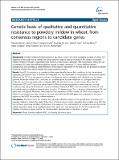Por favor, use este identificador para citar o enlazar a este item:
http://hdl.handle.net/10261/83230COMPARTIR / EXPORTAR:
 SHARE
BASE SHARE
BASE
|
|
| Visualizar otros formatos: MARC | Dublin Core | RDF | ORE | MODS | METS | DIDL | DATACITE | |

| Título: | Genetic basis of qualitative and quantitative resistance to powdery mildew in wheat: from consensus regions to candidate genes |
Autor: | Marone, Daniela; Russo, María A.; Laidò, Giovanni; Vita, Pasquale de; Papa, Roberto; Blanco, Antonio M.; Gadaleta, Ágata; Rubiales, Diego CSIC ORCID ; Mastrangelo, Anna M. | Fecha de publicación: | 19-ago-2013 | Citación: | BMC Genomics 14(1) : 562- (2013) | Resumen: | Abstract Background Powdery mildew (Blumeria graminis f. sp. tritici) is one of the most damaging diseases of wheat. The objective of this study was to identify the wheat genomic regions that are involved in the control of powdery mildew resistance through a quantitative trait loci (QTL) meta-analysis approach. This meta-analysis allows the use of collected QTL data from different published studies to obtain consensus QTL across different genetic backgrounds, thus providing a better definition of the regions responsible for the trait, and the possibility to obtain molecular markers that will be suitable for marker-assisted selection. Results Five QTL for resistance to powdery mildew were identified under field conditions in the durum-wheat segregating population Creso × Pedroso. An integrated map was developed for the projection of resistance genes/ alleles and the QTL from the present study and the literature, and to investigate their distribution in the wheat genome. Molecular markers that correspond to candidate genes for plant responses to pathogens were also projected onto the map, particularly considering NBS-LRR and receptor-like protein kinases. More than 80 independent QTL and 51 resistance genes from 62 different mapping populations were projected onto the consensus map using the Biomercator statistical software. Twenty-four MQTL that comprised 2–6 initial QTL that had widely varying confidence intervals were found on 15 chromosomes. The co-location of the resistance QTL and genes was investigated. Moreover, from analysis of the sequences of DArT markers, 28 DArT clones mapped on wheat chromosomes have been shown to be associated with the NBS-LRR genes and positioned in the same regions as the MQTL for powdery mildew resistance. Conclusions The results from the present study provide a detailed analysis of the genetic basis of resistance to powdery mildew in wheat. The study of the Creso × Pedroso durum-wheat population has revealed some QTL that had not been previously identified. Furthermore, the analysis of the co-localization of resistance loci and functional markers provides a large list of candidate genes and opens up a new perspective for the fine mapping and isolation of resistance genes, and for the marker-assisted improvement of resistance in wheat. | URI: | http://hdl.handle.net/10261/83230 | Identificadores: | http://dx.doi.org/10.1186/1471-2164-14-562 |
| Aparece en las colecciones: | (IAS) Artículos |
Ficheros en este ítem:
| Fichero | Descripción | Tamaño | Formato | |
|---|---|---|---|---|
| 1471-2164-14-562.xml | 189,54 kB | XML | Visualizar/Abrir | |
| 1471-2164-14-562-S6.DOCX | 39,17 kB | Microsoft Word XML | Visualizar/Abrir | |
| 1471-2164-14-562-S7.DOCX | 40,5 kB | Microsoft Word XML | Visualizar/Abrir | |
| 1471-2164-14-562-S10.XLS | 58 kB | Microsoft Excel | Visualizar/Abrir | |
| 1471-2164-14-562-S3.PDF | 4,38 MB | Adobe PDF |  Visualizar/Abrir | |
| 1471-2164-14-562-S1.DOCX | 22,36 kB | Microsoft Word XML | Visualizar/Abrir | |
| 1471-2164-14-562.pdf | 374,19 kB | Adobe PDF |  Visualizar/Abrir | |
| 1471-2164-14-562-S8.DOCX | 33,43 kB | Microsoft Word XML | Visualizar/Abrir | |
| 1471-2164-14-562-S9.XLSX | 33,29 kB | Microsoft Excel XML | Visualizar/Abrir | |
| 1471-2164-14-562-S5.XLSX | 75,45 kB | Microsoft Excel XML | Visualizar/Abrir | |
| 1471-2164-14-562-S4.XLS | 1,14 MB | Microsoft Excel | Visualizar/Abrir | |
| 1471-2164-14-562-S2.DOCX | 23,75 kB | Microsoft Word XML | Visualizar/Abrir |
CORE Recommender
Page view(s)
316
checked on 24-abr-2024
Download(s)
1.352
checked on 24-abr-2024
Google ScholarTM
Check
NOTA: Los ítems de Digital.CSIC están protegidos por copyright, con todos los derechos reservados, a menos que se indique lo contrario.
